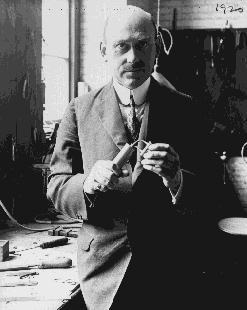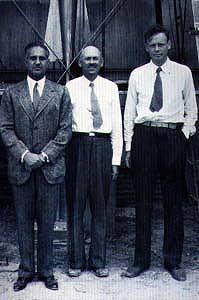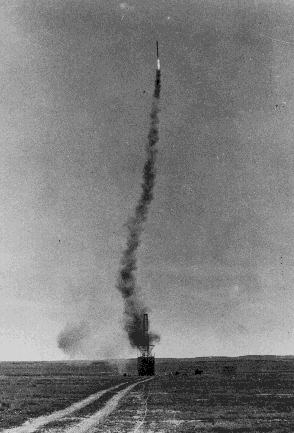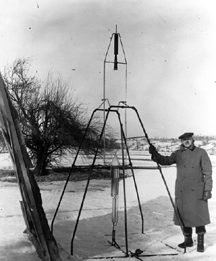
Charles A. Lindbergh interest in rocketry Robert Goddard Biography - The father of modern rocket propulsion
In 1898, a teenage Robert Goddard found his life purpose -- in the pages of a Boston newspaper. Captivated by the compelling realism of a serialized version of H. G. Wells' War of the Worlds, he "imagined how wonderful it would be to make some device which had even the possibility of ascending to Mars."1 He began enthusiastically filling notebooks with ideas for getting off the planet.
While Goddard was a graduate student in physics at Clark College, his youthful speculations crystallized into the pursuit of rocketry. Later, as a professor at Clark, his research began in earnest with a grant from the Smithsonian Institution. For the next twelve years, with intermittent Smithsonian support and occasional funding from other sources, Goddard achieved, in his spare time, many notable firsts in rocketry, including the construction and flight of the first liquid fuel rockets.
By 1926, Goddard had constructed and tested successfully the first rocket using liquid fuel. Indeed, the flight of Goddard's rocket on March 16,1926, at Auburn, Massachusetts, was a feat as epochal in history as that of the Wright brothers at Kitty Hawk. Yet, it was one of Goddard's "firsts" in the now booming significance of rocket propulsion in the fields of military missilery and the scientific exploration of space.
Primitive in their day as the achievement of the Wrights, Goddard's rockets made little impression upon government officials. Only through the modest subsidies of the Smithsonian Institution and the Daniel Guggenheim Foundation, as well as the leaves of absence granted him by Worcester Polytechnic Institute and Clark University, was Goddard able to sustain his lifetime of devoted research and testing. He worked for the U.S. Navy in both World Wars. Eighteen years after his successful demonstration at Auburn, Goddard's pioneering achievements came to life in the German V-2 ballistic missile.
Goddard first obtained public notice in 1907 in a cloud of smoke from a powder rocket fired in the basement of the physics building in Worcester Polytechnic Institute. School officials took an immediate interest in the work of student Goddard. They, to their credit, did not expel him. He thus began his lifetime of dedicated work.
In 1914, Goddard received two U.S. patents. One was for a rocket using liquid fuel. The other was for a two or three stage rocket using solid fuel. At his own expense, he began to make systematic studies about propulsion provided by various types of gunpowder. His classic document was a study that he wrote in 1916 requesting funds of the Smithsonian Institution so that he could continue his research. This was later published along with his subsequent research and Navy work in a Smithsonian Miscellaneous Publication No. 2540 (January 1920). It was entitled "A Method of Reaching Extreme Altitudes." In this treatise, he detailed his search for methods of raising weather recording instruments higher than sounding balloons. In this search, as he related, he developed the mathematical theories of rocket propulsion.
Towards the end of his 1920 report, Goddard outlined the possibility of a rocket reaching the moon and exploding a load of flash powder there to mark its arrival. The bulk of his scientific report to the Smithsonian was a dry explanation of how he used the $5000 grant in his research. Yet, the press picked up Goddard' s scientific proposal about a rocket flight to the moon and erected a journalistic controversy concerning the feasibility of such a thing. Much ridicule came Goddard's way. And he reached firm convictions about the virtues of the press corps which he held for the rest of his life. Yet, several score of the 1750 copies of the 1920 Smithsonian report reached Europe. The German Rocket Society was formed in 1927, and the German Army began its rocket program in 1931. Goddard's greatest engineering contributions were made during his work in the 1920's and 1930's. He received a total of $10,000 from the Smithsonian by 1927, and through the personal efforts of Charles A. Lindbergh, he subsequently received financial support from the Daniel and Florence Guggenheim Foundation. Progress on all of his work was published in "Liquid Propellant Rocket Development," which was published by the Smithsonian in 1936.
Goddard's work largely anticipated in technical detail the later German V-2 missiles, including gyroscopic control, steering by means of vanes in the jet stream of the rocket motor, gimbalsteering, power-driven fuel pumps and other devices. His rocket flight in 1929 carried the first scientific payload, a barometer, and a camera. Goddard developed and demonstrated the basic idea of the "bazooka" two days before the Armistice in 1918 at the Aberdeen Proving Ground. His launching platform was a music rack. Dr. Clarence N. Hickman, a young Ph.D. from Clark University, worked with Goddard in 1918 provided continuity to the research that produced the World War II bazooka. In World War II, Goddard again offered his services and was assigned by the U.S. Navy to the development of practical jet assisted takeoff (JATO) and liquid propellant rocket motors capable of variable thrust. In both areas, he was successful. He died on August 10,1945, four days after the first atomic bomb was dropped on Japan.
Goddard was the first scientist who not only realized the potentialities of missiles and space flight but also contributed directly in bringing them to practical realization. This rare talent in both creative science and practical engineering places Goddard well above the opposite numbers among the European rocket pioneers. The dedicated labors of this modest man went largely unrecognized in the United States until the dawn of what is now called the "space age." High honors and wide acclaim, belated but richly deserved, now come to the name of Robert H. Goddard.
On September 16, 1959, the 86th Congress authorized the issuance of a gold medal in the honor of Professor Robert H. Goddard.
In memory of the brilliant scientist, a major space science laboratory, NASA's Goddard Space Flight Center, Greenbelt, Maryland, was established on May 1, 1959.
Goddard's Historic Firsts
Colonel Charles A. Lindbergh was interested in rocketry and was influential in obtaining financing for Dr. Goddard. He had confided to Lindbergh that if he were given $25,000 a year for four years he could accomplish in 48 months something that otherwise might take a lifetime. Colonel Lindbergh was successful in securing grants from the Guggenheim Foundation. In late 1934, the Lindberghs made a surprise visit to the Mescalero Ranch to see the Goddards, setting the whole town of Roswell abuzz.

Photo courtesy of the Roswell Visitor's Bureau



Robert H. Goddard's basic contribution to missilery and space flight is a lengthy list. As such, it is an eloquent testimonial to his lifetime of work in establishing and demonstrating the fundamental principles of rocket propulsion.

Photo's courtesy of NASA
Privacy Policy | Terms and Conditions | This site is not affiliated with the Lindbergh family,
Lindbergh Foundation, or any other organization or group.
This site owned and operated by the Spirit of St. Louis 2 Project.
Email: webmaster@charleslindbergh.com
® Copyright 2014 CharlesLindbergh.com®, All rights reserved.
Help support this site, order your www.Amazon.com materials through this link.
